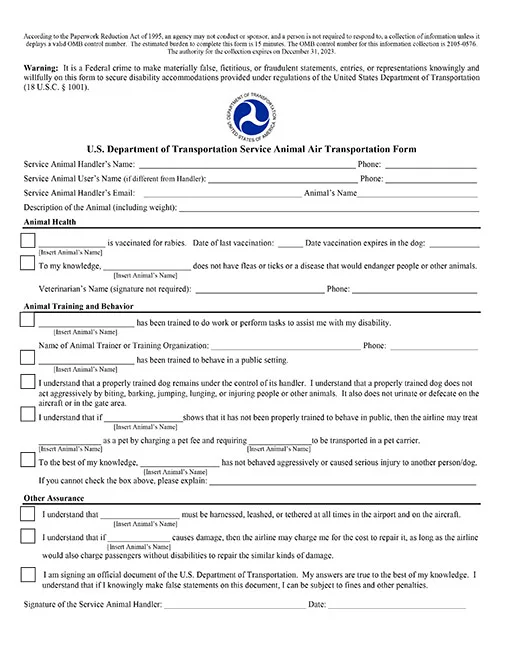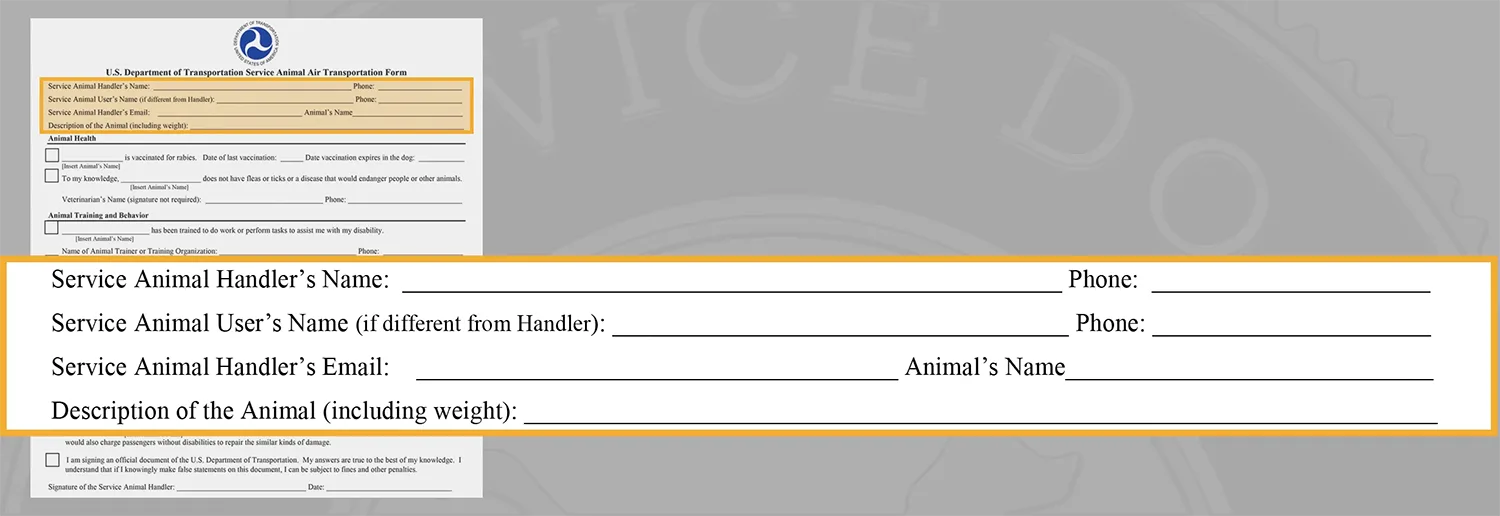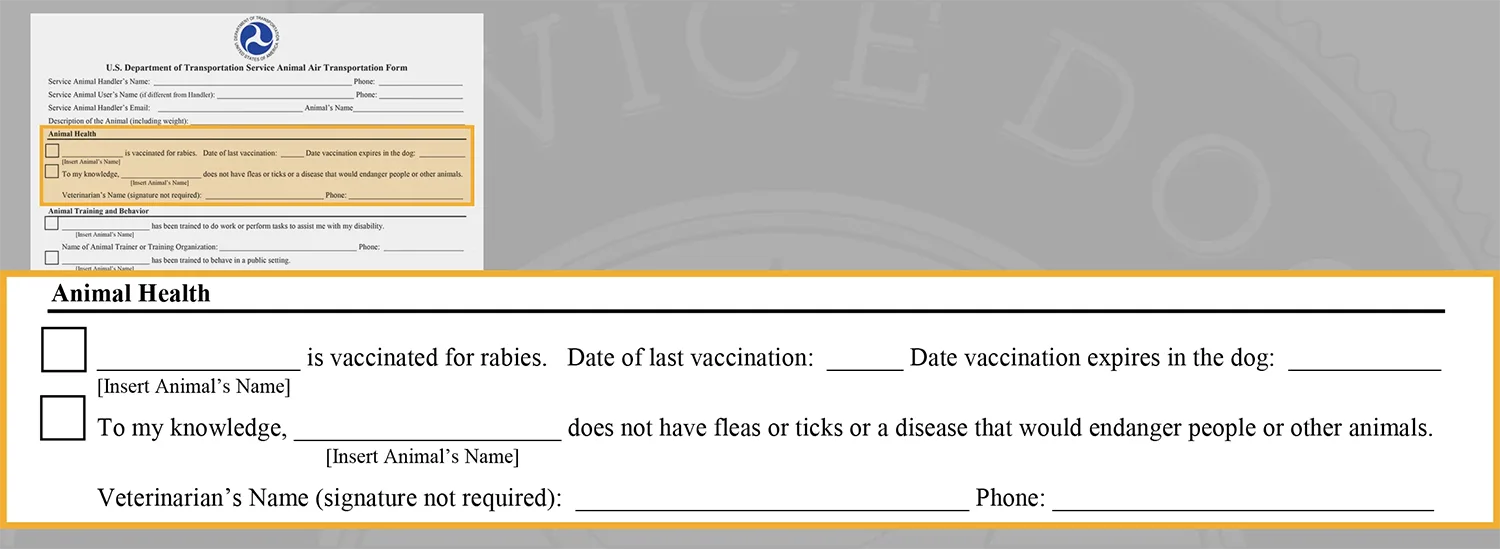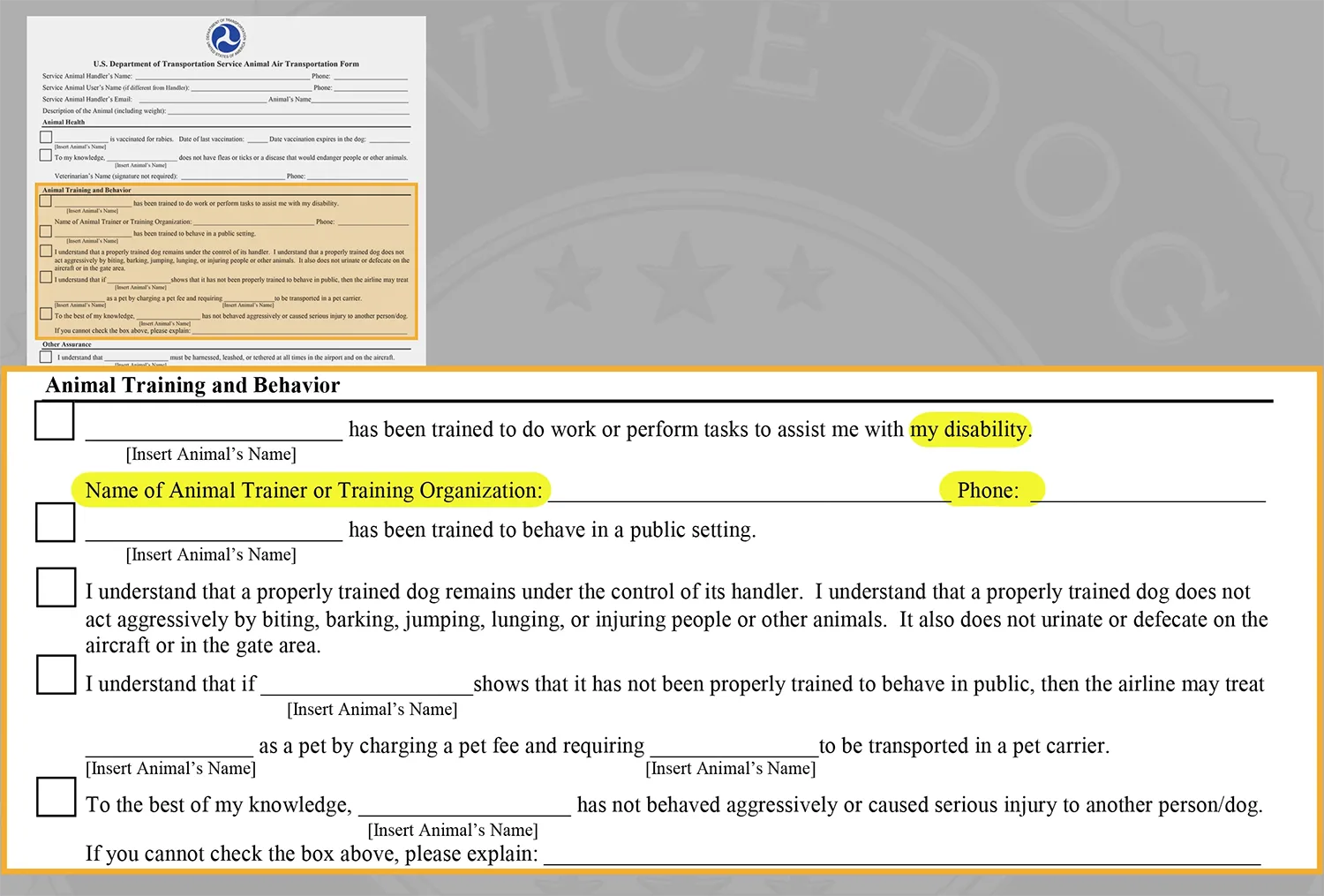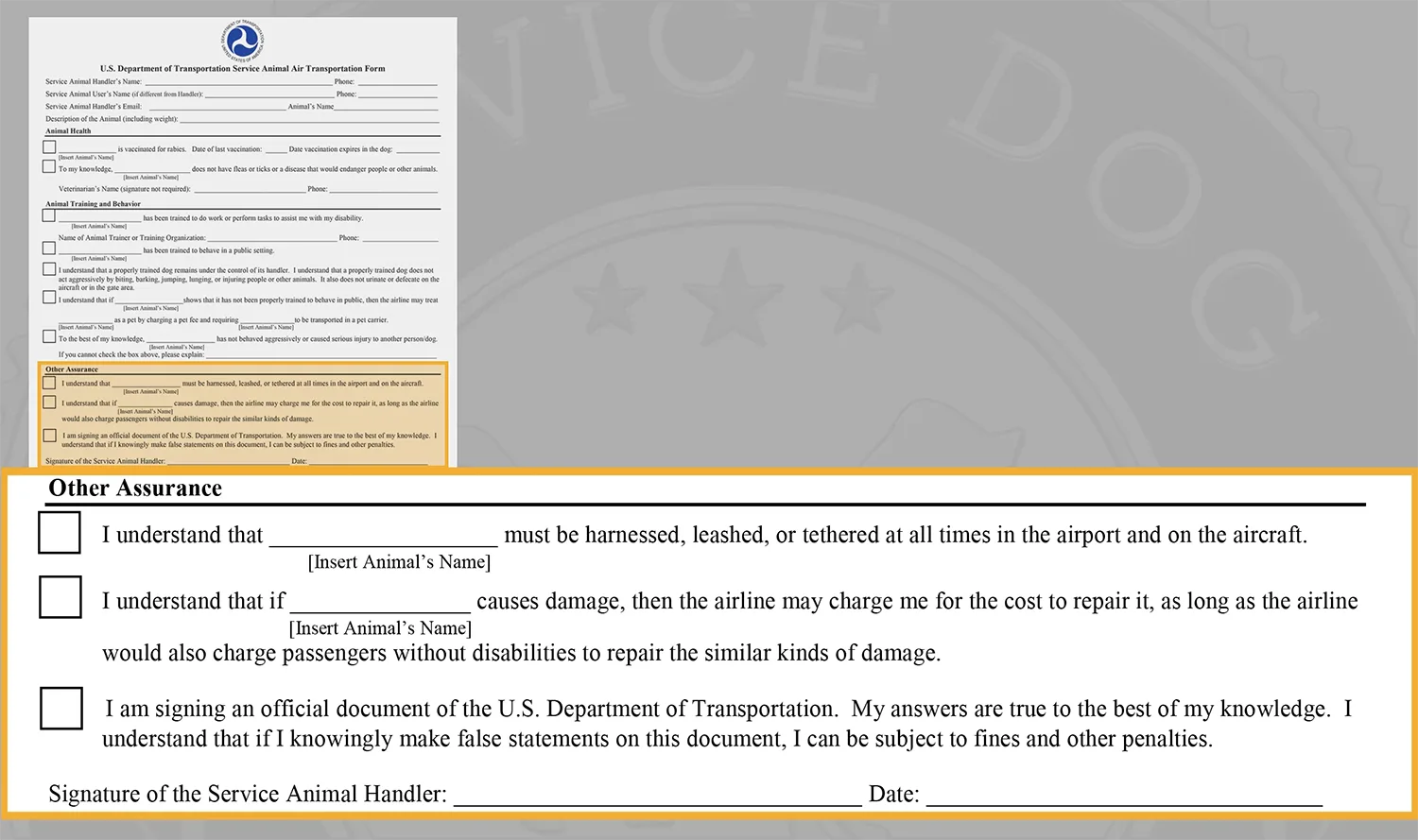How to Use the DOT’s Service Animal Air Transportation Form to Board Flights
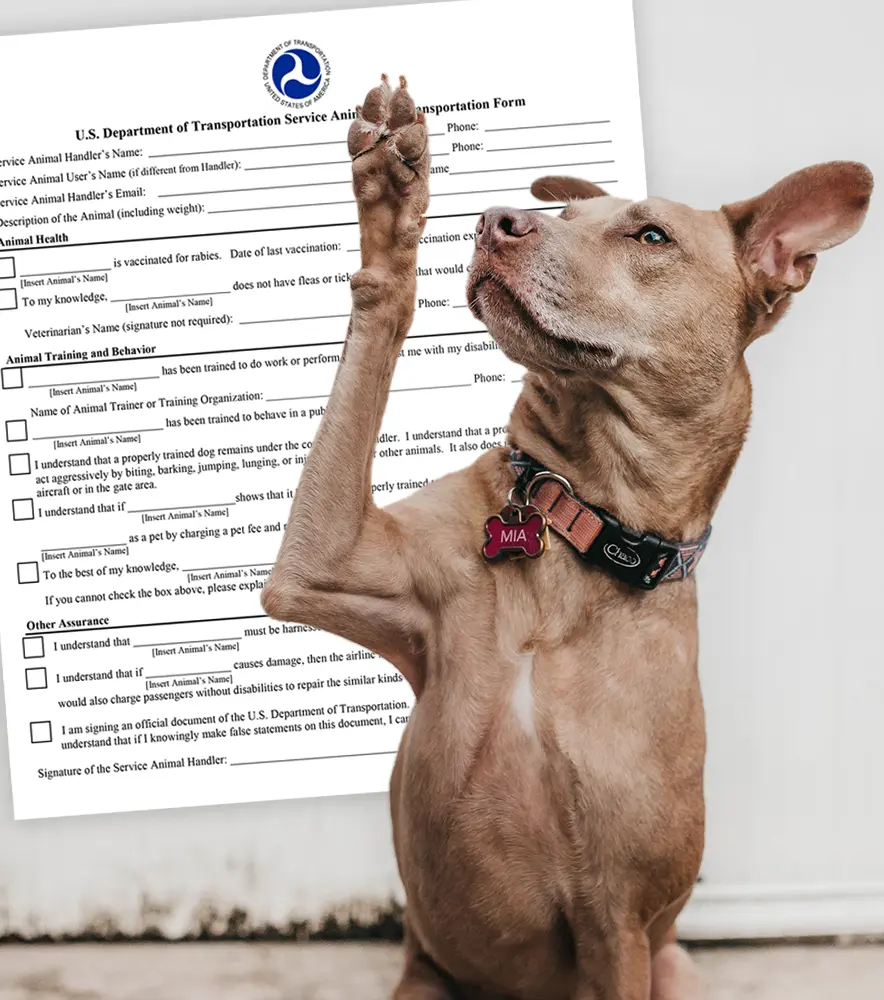
If you plan to fly with a service dog, there is one document you should be familiar with. In 2021, the U.S. Department of Transportation revamped its rules for assistance animals on flights. As a result, emotional support animals were banned on flights, but service dogs maintained their right to board flights as long as the passenger submits a new federal form to the airline before departure.
If you own a service dog, you are allowed to board the cabin of flights free of charge and with an exemption from pet rules under U.S. air travel rules. That includes both service dogs that help with physical disabilities and psychiatric service dogs that help with mental health disabilities.
In this article, we will review the DOT’s Service Animal Air Transportation Form and explain how to use it when flying with your service dog in the future.
Basic Requirements
Before you consider completing the DOT’s Form, there are three essential requirements you must have fulfilled:
- Have an eligible disability
To own a service dog, you must have an eligible physical or mental disability under ADA and ACAA rules.
- Have a task-trained service dog
You must have a dog that has been trained to perform one or more tasks relating to your disability.
- Have a service dog trained for public settings
Your service dog must be capable of behaving at the airport and during the flight.
Read on below for more details on these three requirements.
Information about the Owner and Animal
The first part of the Service Animal Form asks for information about you and your service dog. In most cases, service dog owners will fill in their names as the “Handler” and leave the “User Name” blank. The “User Name” might be needed if the person transporting the service dog is different from the person who needs the dog for their disability. For example, a transporter may be taking a service dog on a flight to meet the dog’s new owner in another location.
The Service Animal Form also asks for the dog’s name and weight. Note that service dogs are not subject to the same weight restrictions as pets on flights. A service dog can sit on the floor in your foot space as long as it does not encroach on the space of another passenger or the aisle.
Animal Health Section
This part of the Service Animal Form asks you to verify that your service dog has been vaccinated for rabies and does not have fleas, ticks, or a disease that would threaten other people or animals.
You must also include your veterinarian’s name and phone number. The Service Animal Form notes that a signature from the veterinarian is NOT required. Your veterinarian’s contact is requested for informational purposes — you make the certifications about your service dog’s health.
Disability and Training Requirement Section
Service Dog Owners Must Have a Disability
The most important part of the Service Animal Form is the section that asks you to verify that your service dog has been trained to assist with a disability. By definition, a service dog must be fully trained to perform a job or tasks relating to a physical or psychiatric disability.
The term “disability” is a legally defined term under federal disability and air travel laws. A disability includes physical conditions like visual impairment or compromised mobility and mental health conditions like severe depression, anxiety, or post-traumatic stress disorder. Whatever the condition may be, it has to “substantially limit” at least one major life activity.
If you believe you may have a psychiatric disability, a licensed mental health professional is best qualified to evaluate whether you meet the eligibility requirements. If a licensed professional such as a therapist or doctor assesses that you have a disability, they can sign a PSD letter for you that puts their findings in writing.
There are penalties and legal consequences for making misstatements on the Service Animal Form. That has caused some anxiety among service dog owners who previously have not been subject to any documentation requirements. For owners with “invisible disabilities,” a PSD letter can provide comfort knowing they have a documented, eligible disability.
Service Dogs Must Be Fully Trained
Whether it is a service dog for a physical or a psychiatric disability, a service dog cannot be considered a legal service animal until it is fully trained to perform tasks that assist with the handler’s disability.
On the Service Animal Form, you must indicate who the trainer or training organization was. If you trained your service dog yourself, you would list yourself. The DOT has made clear you do not need a third-party trainer or organization to have a service dog. Many service dog owners train their dogs on their own without outside assistance, and the DOT recognizes this.
Service Dogs Must Always Be Well Behaved
In addition to being task-trained, service dogs must be trained to handle public settings without causing any disruptions. You must also verify on the Service Animal Form that your service dog has not behaved aggressively or caused serious injury to another person or dog.
Other Assurance Section
The last part of the Service Animal Form asks you to confirm that your service dog will be harnessed, leashed, or tethered at all times at the airport and on the plane. You have to acknowledge that the airline may charge you for repairs if your service dog causes any damage on the plane.
It’s important to recognize that there are consequences for not completing the form accurately. You must check the box acknowledging that you are signing an official U.S. DOT document which can subject you to fines if you knowingly make false statements. You must be truthful about your disability, and the level of service dog training your dog has achieved.
Conclusion
While at the airport, service dog owners should keep in mind that in addition to the Service Animal Form, there are a few other ways airport and airline staff can verify that you have a service animal:
- Airport and airline staff can verbally ask two questions:
1. Is your service dog required because of a disability?, and
2. What work or task has your dog been trained to perform?
Note that they are not allowed to ask for specific details regarding your condition or for your service dog to demonstrate its task on command. - Staff can observe whether the service dog has been properly trained to be in a public setting or if it is disruptive.
- Staff may be on the lookout for physical accessories, such as harnesses and vests, even though these are optional and not required by law.
The Service Animal Form may, at first glance, cause anxiety among service dog owners; after all, before the DOT’s rule changes, service dog owners were generally not accustomed to any type of documentation requirements.
While the new form is a burden for service dog owners, individuals with eligible disabilities and properly trained service dogs should be able to complete the form and make the necessary representations easily.
About the Author: The writing team at Service Dog Certifications is made up of folks who really know their stuff when it comes to disability laws and assistance animals. Many of our writers and editors have service dogs themselves and share insights from their own experiences. All of us have a passion for disability rights and animals.
Related Articles
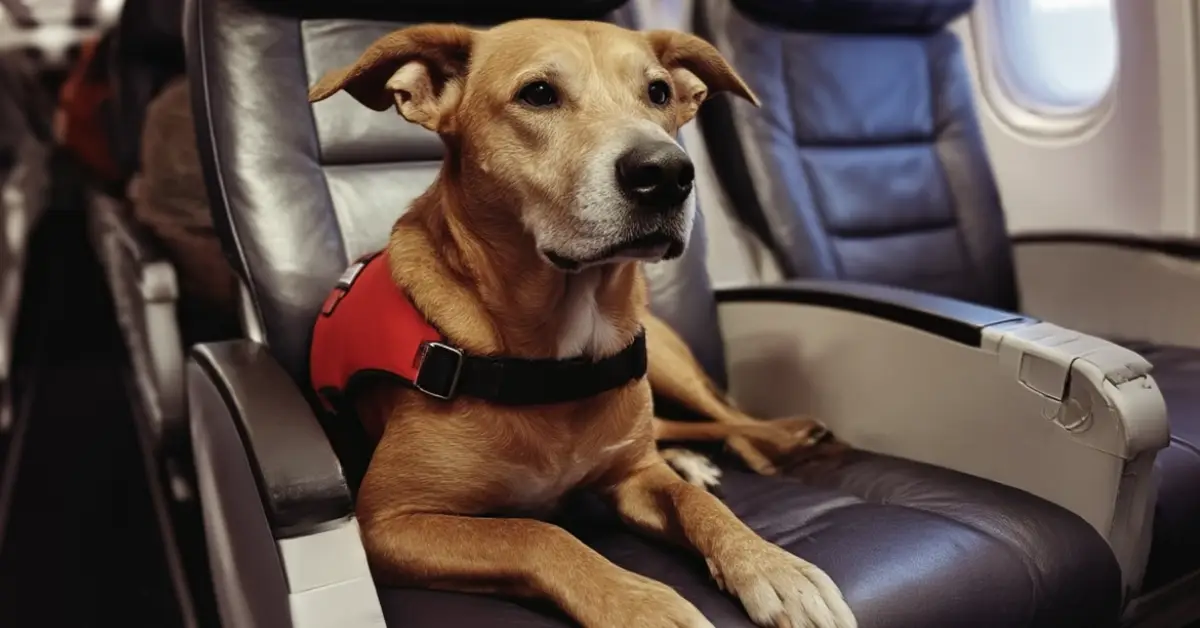
How to Fly With Your Dog Step-by-Step
Taking your dog on an airplane is easy when you know the airline’s policies for both pets and service dogs, and you come prepared. When flying with a service dog, you will have more rights than flying with a dog that’s considered a pet, but the process is similar. This guide walks you through everything […]

Read More

How Do I Fly With My Dog To Hawaii?
It’s travel season and Hawaii is the perfect destination for the summer. Kids are out of school, the weather is warm, and the tropical paradise known as Hawaii is a tourist destination fit for everyone. Even dogs! This blog post will give you some guidelines and information on bringing your pet to the most traveled […]

Read More
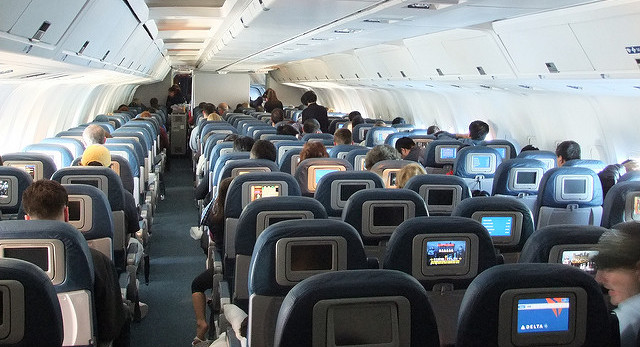
Delta Airlines – 2018 Service Dog Policy
Delta carries approximately 250,000 Service and Emotional Support Animals each year. However, as of March 01, 2018, they are tightening their policy for these working animals in an effort to reduce “misbehavior” by dogs (and other creatures). Although the carrier is required by law to admit Service animals and ESA’s into the cabin of the […]

Read More
